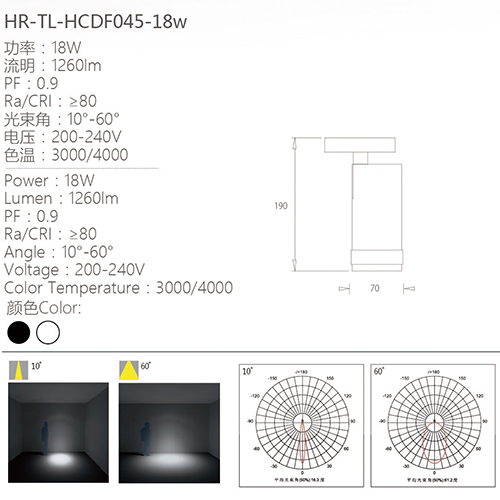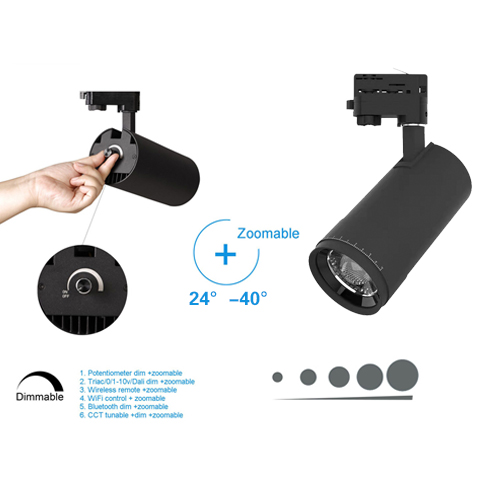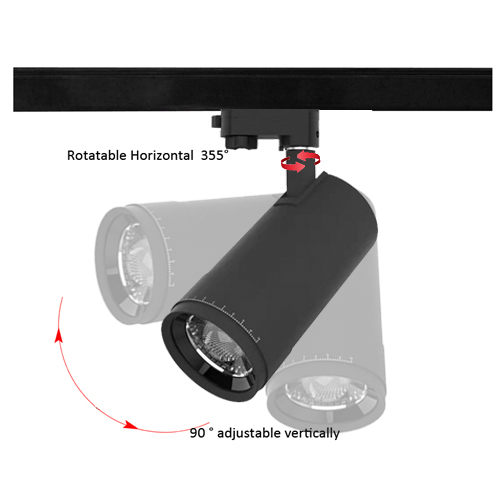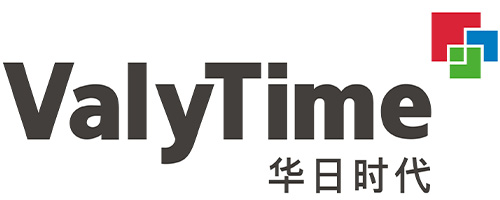Are LED bulbs used in track lights?
As a widely used lamp in modern lighting design, track lights have been widely used in many places such as homes, commercial spaces, retail stores and exhibition halls due to their unique adjustability and flexibility. Track light systems allow users to adjust the direction and position of lamps according to actual needs, thereby achieving precise local lighting or uniform illumination over a large area. With the development of LED technology, more and more track lights are beginning to use LED bulbs as light sources.
This article will delve into the issues related to the use of LED bulbs in track lights, analyze their advantages and disadvantages, and answer this question - are LED bulbs used in track lights?

What is a track light? Construction and principle
A track light is a lamp that can slide on a metal track and adjust the lighting direction. The track itself is connected to the power supply through the power system, and the current is transmitted through the track to the lamp head of the lamp, so that the bulb or lamp emits light. The core advantage of track lights lies in their flexibility. Users can freely move and adjust the direction of the lamp as needed, change the angle of illumination, and thus achieve precise lighting of different areas.
Track lights generally include three main parts:
1. Track system: including electrical rails, support devices and connecting parts. The track system can be installed on the ceiling, wall or other appropriate locations to support the fixing of lamps and the transmission of current.
2. Lamp head: The lamp installed on the track can be rotated and adjusted in different directions as needed. The design of the lamp head usually supports different types of bulbs, and it is also convenient to replace the bulb.
3. Light source (bulb): The core part of the track light, responsible for emitting light. There are many types of light sources, including traditional incandescent bulbs, halogen bulbs, fluorescent bulbs and modern LED bulbs.
For track lights, the bulb is one of the key factors that determine its lighting effect. With the popularization of LED technology, more and more track lights have begun to use LED bulbs as light sources because LED bulbs have the advantages of high energy efficiency, long life, low heat, and environmental protection.

What are the advantages of using LED bulbs in track lights?
With the development of LED technology, the use of LED bulbs in track lights has brought many advantages. For applications in different occasions such as residential, commercial, and art exhibitions, the use of LED bulbs in track lights has greatly improved the lighting effect and its added value.
1. Save energy and reduce electricity bills
LED bulbs are highly energy efficient, so track lights using LED bulbs consume less electricity than traditional bulbs. For example, LED bulbs usually consume more than 80% less electricity than incandescent bulbs of the same brightness. Therefore, track lights using LED bulbs can significantly reduce power consumption in long-term use, thereby helping users save energy and electricity bills.
2. Reduce maintenance costs
The service life of LED bulbs can usually reach 20,000 hours to 50,000 hours, which is much higher than incandescent lamps (about 1,000 hours) and halogen lamps (about 2,000 hours). This means that track lights using LED bulbs require less replacement and maintenance. Traditional incandescent and halogen lamps often need to be replaced frequently due to their high heat generation and short lifespan, while LED bulbs can be used continuously for up to several years. Therefore, track lights using LED bulbs have significant advantages in maintenance costs, especially for places with high-frequency switching, such as shops, museums, etc.
3. Accurate local lighting
One of the biggest features of track lights is their flexible adjustability. Users can adjust the position and irradiation angle of the lamps as needed. With the precise light source of LED bulbs, track lights can provide strong and concentrated lighting, which is suitable for highlighting a certain item or area. For example, local lighting of display cabinets in shopping malls, lighting of artworks in museums, etc., LED bulbs can provide ideal high brightness and delicate lighting effects, highlighting the lighting area to the greatest extent.
4. Flexible selection of color temperature and color rendering index
LED bulbs usually have adjustable color temperature (from warm white to cool white) and have a high color rendering index (CRI), which makes LED track lights more widely used in different occasions. For example, warm white light sources are suitable for creating a warm atmosphere, while cool white light sources are suitable for improving work efficiency. In environments with high color requirements such as art galleries and store displays, LED track lights can provide more realistic and natural color display effects by selecting appropriate color temperature and color rendering index.
5. Environmental protection and safety
LED bulbs do not contain harmful substances such as mercury, making them more environmentally friendly to use. Moreover, LED bulbs have good heat dissipation, avoiding the overheating problem caused by incandescent and halogen lamps and reducing the potential risk of fire. Therefore, LED track lights excel in safety and environmental protection.

What are the disadvantages of using LED bulbs in track lights?
While the use of LED bulbs in track lights brings many advantages, there are also some potential problems and challenges that need to be aware of:
1. High initial purchase cost
Compared with traditional incandescent and halogen bulbs, LED bulbs have a higher initial purchase cost. Although LED bulbs have a longer service life and significant energy-saving effects, the initial investment may make some consumers hesitate. Nevertheless, as the production cost of LED bulbs decreases, more and more consumers are gradually recognizing their advantages of long-term energy saving and low maintenance costs.
2. The need for a suitable power driver
LED bulbs need to be equipped with a suitable power driver (also known as a transformer) to ensure their stable operation and avoid flickering or damage. In the application of track lights, if the power driver is not designed properly, it may affect the performance of the LED bulb, resulting in uneven brightness or shortening the service life of the bulb.
3. The problem of uneven light
Although LED bulbs generally provide efficient and concentrated light, if the track light system is not designed properly, the bulbs may produce strong local lighting and weak surrounding lighting, resulting in uneven light distribution. To solve this problem, it is necessary to ensure that the design and layout of the track lights can ensure uniform light distribution.
As one of the most trusted LED lighting manufacturers in China, Huari Lighting Co., Ltd. has been delivering high-quality lighting solutions for over 25 years. Our factory, spanning 92,000 square meters, is capable of producing over 1 million LED lighting units per month. We offer a wide range of energy-efficient LED products, including LED ceiling lights, track lights, downlights, cabinet lights, and GU10 lamps. Our products are all certified by CE, RoHS, and ISO 9001, ensuring top-notch quality and safety. Huari Lighting provides customized LED solutions and competitive pricing, including wholesale rates and discounted deals for bulk orders. Whether you need affordable lighting products for your commercial or residential project, we offer factory-direct pricing that ensures great value for money.
